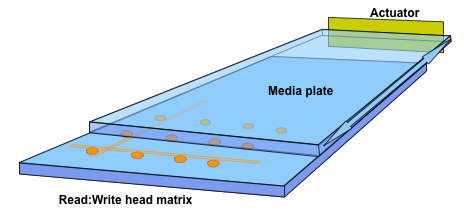Outrageously cool new hard drive

DataSlide has come out of stealth mode with a very creative SSD replacement technology. They call it a Hard Rectangular Disk or HRD.
Here's DataSlide's quick overview:
DataSlide applies technology in new, patented ways to achieve unprecedented high performance 160,000 IOPS & 500MB/sec and low power <4 Watts="" for="" a="" magnetic="" storage="" device:="" <="" p="">
- A piezoelectric actuator keeps the rectangular media in precise motion
- A diamond solid lubricant coating protects the surfaces for years of worry free service
- A massively parallel 2D array of magnetic heads reads from or writes to up to 64 embedded heads at a time
It looks like this:
graphic courtesy of DataSlideShake, rattle & roll But that's not all. According to the redoubtable Chris Mellor at The Register device uses a
. . . 2-dimensional array of 64 read-write heads, operating in parallel, ... positioned above an piezo-electric-driven oscillating rectangular recording surface. . . .
Here's another diagram from DataSlide showing how the data and sectors are oriented:
500 MB/s divided by 64 seems doable for each head. No word on writes.
Chris also reports that Oracle's Embedded Global Business Unit is working with DataSlide to incorporate a database to create a "smart" storage device for use in I/O intensive "multiple concurrent stream" applications.
The company says the drive is at the prototype stage and uses existing high-volume production technologies, including perpendicular recording media, semicondutor lithographic heads and LCD glass treatments.
The Storage Bits take DataSlide has taken from IBM's Millipede concept and reimagined it using common technologies. While much remains to be done to productize the prototype, the fact of such architectural creativity should spur new thinking at the hard drive companies.
Of course, just like SSDs, drives with such low latencies shouldn't be stuck at the end of a long, complex, high-latency interconnect chain. PCI-e HRD card, anyone?
Also, the relatively low capacity - 36GB - of the prototype device suggests it may slot in between larger capacity SSDs and DRAM. Until we know the economics though that is almost baseless speculation.
Let's hope they can get it to market in less than 3 years. And let the based speculation begin!
Comments welcome, of course. This post got a couple of quick updates, including adding the figures, after it was first published.
